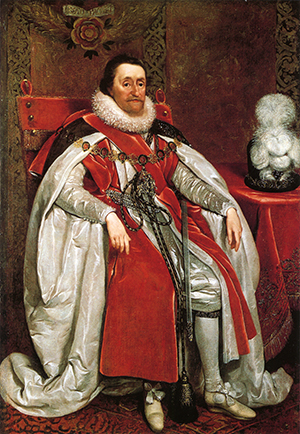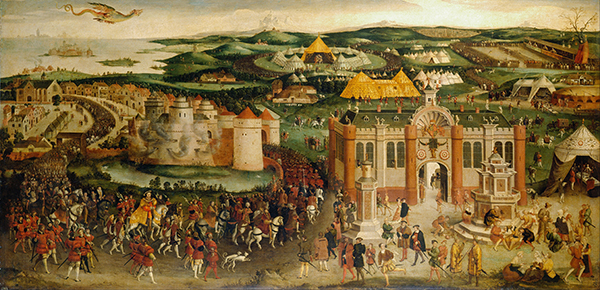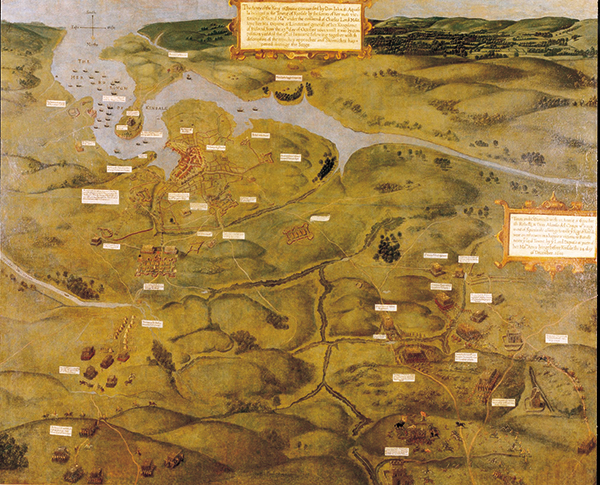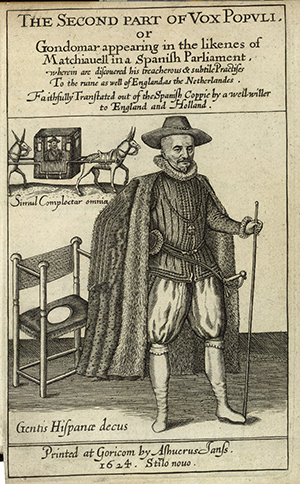The affair of the pictures
Published in Early Modern History (1500–1700), Features, Issue 3 (May/June 2016), Volume 24ON 9 NOVEMBER 1620 MEMBERS OF THE SPANISH DIPLOMATIC DELEGATION TO LONDON DID SIGNIFICANT DAMAGE TO TWO PAINTINGS (ONE OF THE BATTLE OF KINSALE) DEPICTING ENGLISH MILITARY AND DIPLOMATIC TRIUMPHS IN THE LONG GALLERY AT WHITEHALL PALACE. WHAT WAS BEHIND THIS EXTRAORDINARY INCIDENT?
By Hiram Morgan

Above: King James I of England and VI of Scotland by Daniel Mytens. The European crisis, beginning in 1618 with the revolt of the Bohemians against the Austrian Hapsburgs, had escalated the following year when James’s son-in-law, Frederick V, an imperial elector, count of the Rhenish Palatinate and leader of the German Protestant Union, accepted the crown of Bohemia. (NPG)
There are confused reports about what exactly happened in the Long Gallery at Whitehall on 9 November but the context is clear enough. The leader of the Spanish delegation, Diego de Sarmiento de Acuña, Count of Gondomar, had arrived for his second stint as ambassador in May 1620. After his first embassy he was already deeply distrusted by England’s Protestant-dominated media and intelligentsia, having discussed with King James I the possibility of Prince Charles marrying the Infanta Maria Anna, daughter of Philip III of Spain. The European crisis, beginning in 1618 with the revolt of the Bohemians against Austrian Hapsburgs, had escalated the following year when James’s son-in-law, Frederick V, an imperial elector, count of the Rhenish Palatinate and leader of the German Protestant Union, accepted the crown of Bohemia.
‘The present face of Christendom, so miserably and dangerously distracted at this time’
With this ambitious act bringing an avalanche of threats and ultimata from the Hapsburg emperor at the time of Gondomar’s arrival, James then stood on the sidelines, much to the annoyance of public opinion in England, as first the Spaniards occupied the Palatinate and then the Austrians moved to eject the ‘Winter King’ from Prague. Many of James’s British subjects were raising contributions for their fellow Protestants on the Continent and others were joining a volunteer expeditionary force. James, however, in spite of loud protestations to the contrary, was more and more latching onto the Spanish Match as a means of negotiating the restoration of his son-in-law to his original patrimony, thereby avoiding involvement in an expensive multi-front war. On 6 November 1620 he reluctantly summoned parliament—‘the present face of Christendom, so miserably and dangerously distracted at this time’. At this juncture Gondomar was facing more hostility after it leaked out that he was buying up cannon and munitions in England for export to the Catholic armies. Meanwhile he was himself trying to intercede for Henry Carvell, hauled before the courts after he and other English recusants set up a fund for the Catholic cause. It was this case that was being discussed with King James in an adjacent room when the pictures were attacked. There are three accounts of the incident.
Venetian ambassador’s account
The first report was by Girolamo Lando, the Venetian ambassador, sent to the Doge and Senate on 10 November. Like the Venetians in general, Lando was hostile to Spaniards and to Gondomar in particular, though ironically a lot of his detail came from information acquired from Spanish embassy staff:
‘While the ambassador was at the said audience, some members of his household finding themselves alone in a royal gallery containing a large portrait of Henry VIII, with a representation of the capture of Boulogne in France and another picture representing some valorous action of the English in Ireland against the Spaniards, tore up the whole of the head of Henry and the part of the picture representing the town, and also destroyed the other picture about Ireland in which the Spaniards were named. There is a great commotion about this, but perhaps it will die down, as upon other occasions similar affairs of great consequence have been dissimulated. The partisans of the ambassador go about saying that the deed was done on purpose by others in order to throw the blame and the odium upon him and his. They by their proceedings are succeeding in rendering other Catholic foreigners odious and subjecting them to the most rigorous observation.’
(Cal. SP, Venice, 1618–21, p. 480)

Above: Close examination of The Battle of Kinsale in Trinity College, Dublin, reveals visible slash-marks (inset), indicating that it is the original painting attacked in 1620 and not a copy. (Trinity College, Dublin)
Thomas Locke’s account
The following day Thomas Locke, a royal secretary, wrote to Dudley Carleton, English ambassador to the Dutch Republic. Both of these correspondents were English Protestant opponents of Hapsburg designs:
‘This last week the Spanish ambassador had a long audience in the gallery at Whitehall with the king [in] private (saving the Lord Mar, Lord Digby and the Prince). That time his followers were in the next room, where there are many good pieces as your lordship knows amongst others the siege of Kinsale & King Henry his going to Boulogne (which is one of the best there). Out of these were many pieces cut where the Spaniards received any disgrace, in the first that they cut out quite as in one place where the Spaniards is hanged at Kinsale & in the other the king’s head cut off with diverse other such like. This is much spoken of.’
(National Archives, SP 14/117 ff131–2)
Gondomar’s account
Gondomar also wrote home to Philip III the same day. He claimed the incident as a conspiracy contrived to show his embassy in a bad light, blaming not his own servants but one of James’s own:
‘After having gone last week to speak to the king here in his palace, amongst the paintings which are there in a gallery where my servants were with others of the king, the head of a portrait of Henry VIII was found cut off and in another painting of Ireland they cut a big bit of the canvas which was Kinsale with the Spanish surrendered. They told me that it is understood that a Scot in the pay of the malcontents did it to give the impression (as they have done) that my servants did this. And the earl of Montgomery, who is majordomo of the palace and brother of the earl of Pembroke, informs me that the king stated an injury like this done by the Spaniards in the palace could not be tolerated by England nor would it have been tolerated by Queen Elizabeth, and they have made a great hubbub out of this. I have also asked the king to command it to be investigated and punished, assuring him that there are no Spaniards so base or cowardly to fight with paintings, and many servants of his being there certify that after my servants left, they saw the paintings as they were before.’
(Archivo General de Simancas, Estado, 2602).
Henry VIII’s head
While two of the descriptions refer to Henry VIII and Boulogne (and a painting of the Siege of Boulogne, which the king helped conduct in the summer of 1544, once existed in Cowdray House, Sussex, until burned down in 1793), it appears that the artwork featuring Henry VIII was in fact the famous Field of the Cloth of Gold, in which the king is shown on his way to meet Francis I of France in 1520. Even though this diplomatic summit took place on the outskirts of Calais, the painting became associated with Boulogne. It was known as ‘Henry 8 going into the town of Bullen’, and Abraham Van der Doort catalogued it thus in the late 1630s amongst Charles I’s paintings. Most importantly from our point of view, it is evident from a close examination of the painting—now at Hampton Court—that at some point Henry VIIII’s head was cut out and later restored.
This excision was first noted by Sir Joseph Ayloffe (1708–81) when he gave the first substantial description of the famous painting in 1773:
‘The case was this; after the death of King Charles I, a French agent expressed his desire of purchasing this picture from the commissioners appointed by the parliament for the sale of [the] then late king’s goods. Philip, Earl of Pembroke, who was a great admirer and a most excellent judge of painting, and considered this valuable picture as an honourable piece of furniture in an English palace, came privately into the royal apartments, cut out that part of the picture where the King Henry’s head was painted, and, putting it into his pocket-book, retired unnoticed. The French agent, finding the picture mutilated, and that in so material a part, declined all further thought of purchasing it. By this means it remained in the palace till Cromwell put a stop to the dispersion of the royal collection. After the Restoration, the then Earl of Pembroke delivered the mutilated piece to King Charles II, who immediately ordered it to be restored to its place. By looking at this picture sideway against the light, the insertion of the piece is very visible.’
Ayloffe was unaware of the mutilations done to paintings in Whitehall in 1620, as the state paper sources (English, Spanish and Venetian) were then still held in secret. Would he have been so willing to convey this apocryphal story had he known that Philip Herbert, earl of Pembroke, who supposedly saved the Field of the Cloth of Gold from a French bargain-hunter by getting out his pocket knife, was the same man—previously ennobled as Montgomery—who expostulated with Gondomar over the cuts inflicted on the paintings at Whitehall 30 years earlier?

Above: Close examination of The Battle of Kinsale in Trinity College, Dublin, reveals visible slash-marks (inset), indicating that it is the original painting attacked in 1620 and not a copy. (Trinity College, Dublin)
Battle of Kinsale painting
It was generally thought that the other painting damaged in 1620 was no longer extant, and that the existing painting of the Battle of Kinsale in Trinity College, Dublin, which was brought over from England in 1784, is at best a copy of the Whitehall one. Both research and close examination, however, show it to be the original. First of all, there is the following description in Van der Doort’s catalogue: ‘A Whitehall picture, being part of the kingdom of Ireland, painted in the manner of a map of all the country about Kinsale, where the Spaniards were beaten out of Ireland, in a black wooden frame: 5f. 9; 7f.2’. This corresponds exactly to the content of the Trinity painting; its slightly different dimensions today (5ft 8in. by 7ft 11in.), especially its breadth, are explained by the extra strip of the painting evidently found on the left-hand side of the canvas when it was at some point reframed.
Furthermore, and most significantly, the Trinity painting has evidence of slash marks in at least four areas, which can be seen and photographed from an angle when the sun shines on it from the right. Considerable damage was done to this painting by sharp instruments that required careful repair to leave the marks barely visible. To see how well such slashes can be repaired, compare the glory that is still the Rokeby Venus to the black-and-white photographs of damage done to her 100 years ago by a suffragette wielding a meat cleaver! One of the most interesting areas of repair on the Kinsale painting is the patch in the bottom right-hand corner. There is no detail in this section now other than brownish green paint. We know of the English executions of some of those captured in the battle—almost certainly Irish prisoners rather than Spanish ones—but these do not appear in the surviving painting. If Locke’s statement ‘where the Spaniards is hanged’ referred to something concrete such as a scaffold and hanging men rather than a euphemism for total defeat, then perhaps that feature, having been completely destroyed, either could not be satisfactorily repaired or was not attempted, to avoid causing the honour-obsessed Spaniards further offence. Whatever the case here, there is no reason for further speculation about the Trinity painting itself. It quite clearly is the same painting as once hung in Whitehall, the only difference being that, unlike the Field of the Cloth of Gold, it was not reacquired for the royal collection after the Civil Wars but rather stayed in private hands—most likely the earls of Scarborough—until it was brought to Ireland by the antiquarian General Charles Vallancey.
Dirty tricks?

Above: A satirical image of the leader of the Spanish delegation, Diego de Sarmiento de Acuña, Count of Gondomar (the most controversial foreign representative in Britain prior to Ribbentrop), from the subsequent, second, edition of Vox Populi.
Had the Spaniards visiting the palace been incited? Did some courtier point out the great Henry VIII, reminding them of his break with Rome and his divorce of Katherine of Aragon? Had the Spaniards been taunted about their failed invasion of Ireland? In the tense political situation everyone was on tenterhooks. The Spanish delegation was very wary of insults, which by this stage were being bandied about wholesale. Furthermore, it was on the alert for dirty tricks. Gondomar’s first audience with the king earlier in the year had seen an alarming collapse of a floor where his servants—following behind him in a group—had fallen fifteen feet onto a courtyard below. Gondomar dismissed that incident as an accident but his followers were not so sure. Is it possible that Protestant extremists in the palace could have done the damage to cause a rift between James and Gondomar? It seems unlikely but it is not impossible. Just at this time the first copies of Thomas Scott’s famous pamphlet Vox Populi, printed in Holland, were beginning to circulate anonymously. Scott, a former royal chaplain and associate of the Herbert brothers, advanced an archetypal popish plot, claiming that a Spanish council meeting attended by the papal nuncio before Gondomar’s departure had developed a plan to bring England into the Catholic fold and that he had since gained control over the king and bribed his advisers. It is paradoxical that Gondomar should blame a Scot by nationality rather than by surname for damaging the pictures. Perhaps that name was already in the air, though the ambassador had not heard about Vox Populi when he was reporting the picture incident on 11 November.
The further extraordinary thing is that James himself does not seem to have been too put out by the incident. Surely, in an age of political assassination, men angrily drawing their swords in his near presence should have been a cause of great alarm and serious diplomatic consequences should have followed? Maybe he did not care much for paintings celebrating the achievements of the Tudors. At any rate, he was willing to accept Gondomar’s excuses and move on with the bigger political agenda. One thing is certain, though: James did not personally order the paintings to be destroyed in deference to the Spaniards. Lyon in his 1910 biography of Gondomar claims that James’s ‘infatuation had reached such a pitch that he spoilt several pictures in the Whitehall gallery by having pieces which reflected badly on the Spaniards cut out of the canvas’. This is a misreading—historiographically determined by the propaganda that has prevailed since Scott’s publication—of the terse summary of Locke’s letter contained in the Calendar of State Papers, Domestic. It is in fact one of a number of incidents where Victorian and Edwardian historians misconstrued James’s working relationship with Gondomar as one of increasing subservience.
Crisis deepens
In December the crisis deepened. Gondomar, already referred to as ‘the devil’ in popular parlance, was being mobbed in his litter and threatened with death by passers-by. After rumours of an assassination attempt, the king had to provide a bodyguard for the Catholic king’s ambassador. News of the Catholic victory over Frederick’s forces at the Battle of White Mountain brought matters to a high pitch, and with the circulation of Scott’s pamphlet conspiracy theories were rampant. Gondomar was now foaming with anger about the pamphlet and complained to the king. As a result James, concerned about ‘republicanising’ tendencies, issued on Christmas Eve 1620 ‘a proclamation against an excesse of lavish and licentious speech of matters of state’. Not surprisingly, parliament, which met in January, could not be controlled and was soon suspended.
In all this turmoil the brief affair of the pictures was soon forgotten. It shows, whatever actually took place, just how tense religious and political matters were in the winter months of 1620–1 and what a dangerous mix they made. Still, it remains an extraordinary incident. How was the king’s security so lax that swords could be drawn and such a frenzied attack happen in his close proximity? Why wasn’t he more worried about it? Might this apparent lack of concern on James’s part indicate that there were some behind-the-scenes shenanigans designed by Protestant extremists to embarrass the embassy of the Catholic king? On the other hand, if the Spaniards were involved, even though the ambassador was denying it, why were some of his servants not disciplined or sent home? Why wasn’t there a public reaction to the picture incident in plays, pamphlets and the like, especially when Henry VIII, who had removed a few heads himself, had been symbolically beheaded? Even though this type of evidence does not exist, the slash marks and cuts on the paintings themselves remain testimony enough.
Hiram Morgan lectures in history at University College Cork.
FURTHER READING
Sir J. Ayloffe, An historical description of an ancient picture in Windsor Castle (London, 1773).
K. Ferguson, ‘The battle of Kinsale and other military associations with the Library of Trinity College, Dublin’, The Irish Sword 26 (2011), 263–86.
F.H. Lyon, Diego de Sarmiento de Acuña, Conde de Gondomar (Oxford, 1910).
O. Millar (ed.), Abraham van der Doort’s Catalogue of the collections of Charles I (London, 1958–60).
The author wishes to acknowledge the assistance of Francis Kelly and Stephen Boyd, UCC.
















